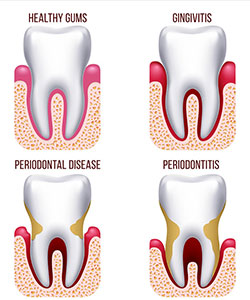Gum Disease

Gum disease, also known as periodontal disease, is an infection of the gums surrounding your teeth. Gum disease is one of the top reasons for tooth loss in adults, and because it is virtually pain-free, many patients do not know they have the disease. During each regular checkup, your dentist will check for signs of periodontal disease by measuring the space between your teeth and gums.
What causes gum disease?
Gum disease is caused by a buildup of plaque (a sticky form of bacteria that forms on the teeth). If the plaque is not removed (by flossing, brushing, and regular dental checkups), it will continue to build up and create toxins that can damage the gums. Periodontal disease forms just below the gum line and creates small pockets that separate the gums from the teeth. Periodontal disease has two stages: gingivitis and periodontitis.
- Gingivitis — This is the early stage of gum disease, when the gums become red and swollen, and bleed easily. At this stage, the disease is treatable and can usually be eliminated by daily brushing and flossing.
- Periodontitis — If left untreated, gingivitis will advance into periodontitis, and the gums and bone that support the teeth will become seriously and irreversibly damaged. Gums infected with periodontitis can cause teeth to become loose, fall out, or be removed by a dentist.
Certain factors can increase a patient's risk of developing periodontal disease, including:
- Smoking or using chewing tobacco
- Diabetes
- Certain types of medication such as steroids, anti-epilepsy drugs, cancer therapy drugs, calcium channel blockers, and oral contraceptives
- Bridges that no longer fit properly
- Crooked teeth
- Old fillings
- Pregnancy
While it is possible to have periodontal disease and not know it, some symptoms can include:
- Gums that bleed easily
- Red, swollen, tender gums
- Gums that have pulled away from the teeth
- Persistent bad breath or bad taste
- Pus between your teeth and gums
- Permanent teeth that are loose or separating
- Any change in the way your teeth fit together when you bite
- Any change in the fit of partial dentures
Treating Gum Disease
Treatments for gum disease can vary depending on the severity of each individual case. Typical treatments include:
- Non-surgical treatments such as at-home periodontal trays, and scaling and root planing (deep cleaning)
- Periodontal surgery and laser gum surgery
- Dental implants
Preventing Gum Disease
Regular dental checkups and periodontal examinations are important for maintaining your health and the health of your smile. You don't have to lose teeth to periodontal disease, and by practicing good oral hygiene at home, you can significantly reduce your chances of ever getting gum disease. Remember to brush regularly, clean between your teeth, eat a balanced diet, and schedule regular dental visits to help keep your smile healthy.
Arestin®
Arestin is a topical antibiotic for gum disease that treats the bacteria that cause periodontal disease in the first place. Along with scaling and root planing treatment, Arestin can assist in preventing your periodontal disease from getting worse and allow you to have a healthy mouth for years to come.
Arestin is a powder composed of hundreds of thousands of tiny microspheres that release antibiotics over time. After a deep periodontal cleaning, scaling, and root planing, your periodontist will add Arestin to the pocket between your gum and tooth. Completely painless, the Arestin powder will dissolve on its own but will continue working long after your visit is over.
At-Home Care With Perio Protect®
Perio Protect is a comprehensive method customized for individual patients to help manage biofilms, which are communities of bacteria growing in the spaces or pockets between teeth and gum tissue. The overall goal of the Perio Protect Method® is to manage oral biofilm with minimally invasive dentistry for lasting oral health.
The Perio Protect Healing Process
The Perio Protect Method is a combination of treatments, including a non-invasive chemical debriding (removal) therapy used in conjunction with traditional mechanical debriding procedures. The chemical therapy involves a series of Perio Trays® that deliver doctor-prescribed solutions to the infected areas of the mouth.
The standard cleaning procedures in dental offices, such as scaling and root planing, help to remove plaque and tartar while also reducing bacteria. Unfortunately bacteria reproduce quickly and biofilms regenerate very easily, so it is difficult to control them between office visits.
With the Perio Protect Method, you can place prescribed solutions into periodontal pockets with an appropriately formed, customized dental tray between office visits to help manage biofilm. Although a dentist must choose the most appropriate solution for you, the most commonly prescribed solution with the Method has oxidizing and oxygenating agents. Oxidizing agents both cleanse the oral wounds and remove the slimy, protective coating of biofilm.
Your dentist may choose to treat your oral wounds with the chemical debriding and cleansing agents before mechanical debriding procedures to help reduce bacterial populations and thus reduce the risk of introducing bacteria into the bloodstream during mechanical debridement.
Perio Tray®
Perio Trays were approved by the FDA in 2004 with the intended use to place solutions of the clinician's choice into gingival crevices or periodontal pockets, the space that can develop between teeth and gum tissues when gum disease is present. Dentists may prescribe Perio Trays when medications placed into the periodontal pocket could benefit a patient's oral health.
A Perio Tray is uniquely designed to precisely fit each patient. An impression of your mouth will be taken and sent with a prescription to a specialized dental laboratory for custom fabrication. Patients will receive detailed usage instructions based on their individual needs. For most people, the Perio Tray is used for only minutes each day. Patients describe the Perio Tray as comfortable, convenient, and easy to use. They especially appreciate its non-invasive technology.
Is the Perio Protect Method Right for Me?
While your doctor should determine the most appropriate care for your conditions, it is important to manage oral biofilm (oral bacterial communities) daily because bacteria are constantly introduced into the mouth. The goal of the Perio Protect Method is to promote lasting oral health without requiring repetitive invasive procedures.
Brushing and flossing continue to be important, but even with standard home care, 80% of Americans have some form of gum disease and need more help. Gum disease has been linked to serious systemic illnesses. Treatment is important.
Schedule an appointment with your periodontist today so that a treatment plan can be developed just for you.


 Website Powered by Sesame 24-7™
Website Powered by Sesame 24-7™